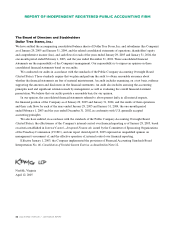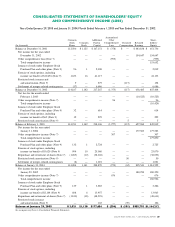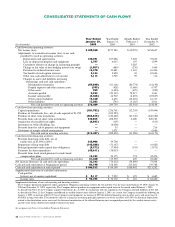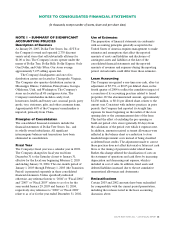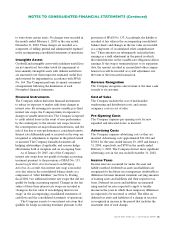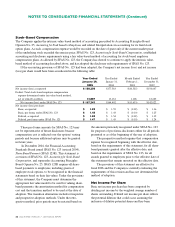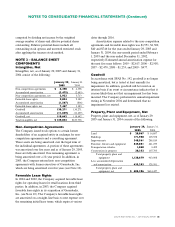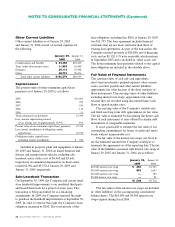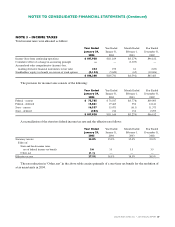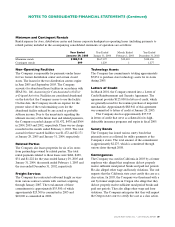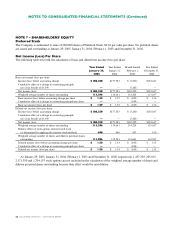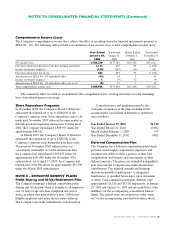Dollar Tree 2004 Annual Report Download - page 38
Download and view the complete annual report
Please find page 38 of the 2004 Dollar Tree annual report below. You can navigate through the pages in the report by either clicking on the pages listed below, or by using the keyword search tool below to find specific information within the annual report.
34 DOLLAR TREE STORES, INC. • 2004 ANNUAL REPORT
Stock-Based Compensation
The Company applies the intrinsic value-based method of accounting prescribed by Accounting Principles Board
Opinion No. 25, Accounting for Stock Issued to Employees, and related Interpretations in accounting for its fixed stock
option plans. As such, compensation expense would be recorded on the date of grant only if the current market price
of the underlying stock exceeded the exercise price. SFAS No. 123, Accounting for Stock-Based Compensation, established
accounting and disclosure requirements using a fair value-based method of accounting for stock-based employee
compensation plans. As allowed by SFAS No. 123, the Company has elected to continue to apply the intrinsic value-
based method of accounting described above, and has adopted the disclosure only requirements of SFAS No. 123.
If the accounting provisions of SFAS No. 123 had been adopted, the Company’s net income (loss) and net income
(loss) per share would have been as indicated in the following table:
Year Ended Year Ended Month Ended Year Ended
January 29, January 31, February 1, December 31,
2005 2004 2003 2002
Net income (loss) as reported $ 180,250 $177,583 $(10,525) $154,647
Deduct: Total stock-based employee compensation
expense determined under fair value based method,
net of related tax effects 13,007 13,181 1,108 12,625
Net income (loss) under SFAS No. 123 $ 167,243 $164,402 $(11,633) $142,022
Net income (loss) per share:
Basic, as reported $ 1.59 $ 1.55 $ (0.09) $ 1.36
Basic, pro forma under SFAS No. 123 $ 1.48 $ 1.43 $ (0.10) $ 1.25
Diluted, as reported $ 1.58 $ 1.54 $ (0.09) $ 1.35
Diluted, pro forma under SFAS No. 123 $ 1.47 $ 1.43 $ (0.10) $ 1.24
the amounts previously recognized under SFAS No. 123
for purposes of pro forma disclosures either for all periods
presented or as of the beginning of the year of adoption.
The prospective method requires that compensation
expense be recognized beginning with the effective date,
based on the requirements of this statement, for all share-
based payments granted after the effective date, and
based on the requirements of SFAS No. 123, for all
awards granted to employees prior to the effective date of
this statement that remain unvested on the effective date.
The provisions of this statement are effective for
fiscal 2006 and the Company is currently evaluating the
requirements of this revision and has not determined the
method of adoption.
Net Income Per Share
Basic net income per share has been computed by
dividing net income by the weighted average number of
shares outstanding. Diluted net income per share reflects
the potential dilution that could occur assuming the
inclusion of dilutive potential shares and has been
These pro forma amounts for SFAS No. 123 may
not be representative of future disclosures because
compensation cost is reflected over the options’vesting
periods and because additional options may be granted
in future years.
In December 2004, the Financial Accounting
Standards Board issued SFAS No. 123 (revised 2004),
Share-Based Payment (SFAS 123R). This statement is
a revision of SFAS No. 123, Accounting for Stock-Based
Compensation, and supersedes Accounting Principles
Board Opinion No. 25. SFAS 123R requires all share-
based payments to employees, including grants of
employee stock options, to be recognized in the financial
statements based on their fair values. Under the provisions
of this statement, the Company must determine the
appropriate fair value model to be used for valuing share-
based payments, the amortization method for compensation
cost and the transition method to be used at the date of
adoption. The transition alternatives include retrospective
and prospective adoption methods. Under the retro-
spective method, prior periods may be restated based on
NOTES TO CONSOLIDATED FINANCIAL STATEMENTS (Continued)




